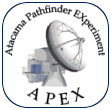 APEX, the Atacama Pathfinder Experiment, is a
collaboration between Max Planck Institut für Radioastronomie
(MPIfR) at 55%, Onsala Space Observatory (OSO) at 13%,
and the European Southern Observatory (ESO) at 32% to construct
and operate a modified ALMA prototype antenna as a single dish
on the high altitude site of Llano Chajnantor. The telescope
was manufactured by VERTEX Antennentechnik in Duisburg, Germany.
APEX, the Atacama Pathfinder Experiment, is a
collaboration between Max Planck Institut für Radioastronomie
(MPIfR) at 55%, Onsala Space Observatory (OSO) at 13%,
and the European Southern Observatory (ESO) at 32% to construct
and operate a modified ALMA prototype antenna as a single dish
on the high altitude site of Llano Chajnantor. The telescope
was manufactured by VERTEX Antennentechnik in Duisburg, Germany.
Observing with APEX allows us to study cold dust and gas in our own Milky Way and in distant galaxies. Tracing the thermal continuum emission and analyzing high frequency spectral lines improve our understanding of the structure and chemistry of planetary atmospheres, dying stars, regions of star formation as well as distant starburst galaxies. We can address issues from the vast scales of the structure of the Universe down to the physics and chemistry of comets.
Because of the COVID-19 contingency, as of March 25th the Observatory works in Survival mode, with many systems and instruments in standy by. For more details and the latest status, please check the ESO announcement.
Observations |
Site Information and Logistics |
|
|
|
|
|
|
|
|
|
|
|
Safety |
|
|
|
|
|

|
The APEX project |
Miscellaneous Information |
|
|
|

|
|
|
|
|




